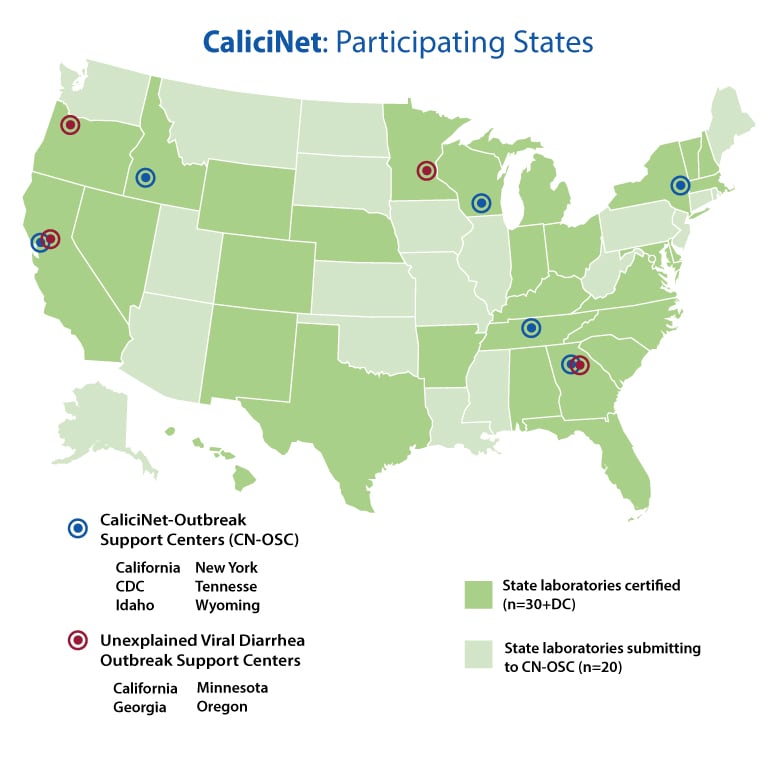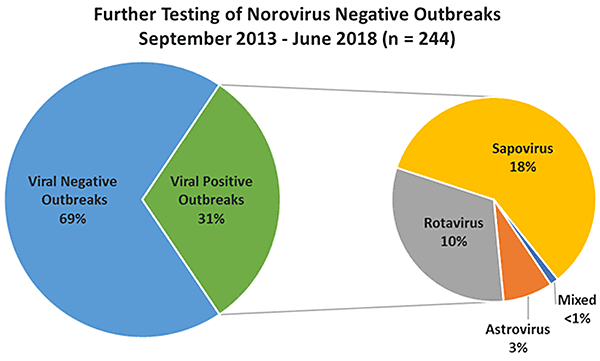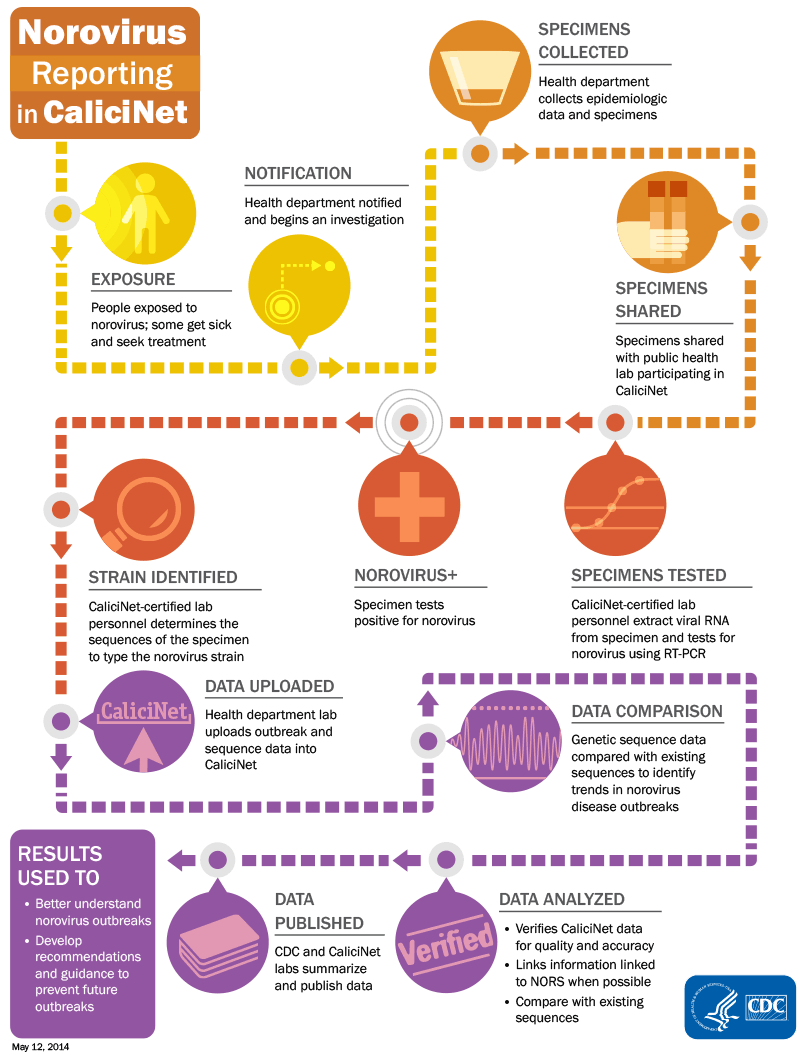Frequently Asked Questions and Answers About CaliciNet
Q: What is CaliciNet?
A: CaliciNet is a national norovirus outbreak surveillance network of federal, state, and local public health laboratories. CDC launched CaliciNet in 2009 to collect information on norovirus strains associated with gastroenteritis outbreaks in the United States. Public health laboratories electronically submit laboratory data, including genetic sequences of norovirus strains, and epidemiology data from norovirus outbreaks to the CaliciNet database. The norovirus strains can be compared with other norovirus strains in the database, helping CDC link outbreaks to a common source, monitor norovirus strains that are circulating, and identify new emerging norovirus strains.
Q: Why is CaliciNet important?
A: CaliciNet focuses on norovirus, the leading cause of acute gastroenteritis and foodborne-disease illness in the United States as well as sapovirus. Together these viruses belong to the human caliciviruses that cause diarrheal disease. Through CaliciNet, participating public health laboratories identify norovirus strains that cause gastroenteritis outbreaks. This is critical for linking outbreaks to a common source, such as contaminated food, monitoring circulating strains, and identifying new emerging strains, such as GII.P16-GII.4 Sydney. The information collected through CaliciNet helps public health professionals better understand noroviruses and develop interventions to prevent them from spreading.
Q: How did CaliciNet get its name?
A: Noroviruses, together with sapoviruses, are part of the family Caliciviridae or caliciviruses. The name calicivirus is derived from the cup-shaped depressions seen on the virus particles when viewed using an electron microscope.
Q: What types of data does CaliciNet collect?
A: The CaliciNet database includes:
- genetic sequences of norovirus strains associated with gastroenteritis outbreaks in the United States, and
- basic epidemiologic data, such as transmission route and outbreak setting.
For more information, see CaliciNet data.
Q: How are data collected through CaliciNet?
A: Participating public health laboratories use standardized laboratory protocols to examine the genetic makeup of norovirus strains. These laboratories electronically submit laboratory data, including genetic sequences of norovirus strains, and basic epidemiologic data from outbreaks to the CaliciNet database.
Q: How can data collected through CaliciNet be used?
A: The data on norovirus strains are compared with existing norovirus sequences in the CaliciNet database. This information can be used to:
- link clusters of norovirus illness to a common source, such as contaminated food
- standardize typing of norovirus strains
- monitor circulating strains
- detect and identify emerging strains of norovirus
Q: How can laboratories participate in CaliciNet?
A: Participation in CaliciNet is limited to federal, state, and local public health laboratories in the United States. These laboratories can participate in CaliciNet by:
- Completing a certification process to actively participate in the network.
- Partnering with a certified CaliciNet Outbreak Support Center (CN-OSCs) or CDC’s National Calicivirus Laboratory to report norovirus outbreak data to CaliciNet. There are currently NC-OSCs in California, Idaho, New York, Tennessee, and Wisconsin.
Q: Do laboratories need to renew their certification?
A: Yes. Participating laboratories must pass a proficiency test bi-annually to maintain certification.
Q: How many laboratories are currently certified to participate?
A: As of August 2018, 34 laboratories in 29 states and the District of Columbia have been certified to participate in CaliciNet. Laboratories that are not certified can submit outbreak specimens for norovirus typing to one of the five CaliciNet Outbreak Support Centers (CN-OSCs) or to CDC’s National Calicivirus Laboratory.

Three CaliciNet laboratories serve as Unexplained Viral Diarrhea Outbreak Support Centers (UVD-OSCs) including state health laboratories in California, Minnesota and Oregon. These UVD-OSC sites are tasked to test stool specimens from norovirus negative outbreaks submitted by CaliciNet laboratories for other viral enteric pathogens including rotavirus, sapovirus, astrovirus and adenovirus. Virus-positive samples are genotyped and virus-negative samples are further tested by next generation sequencing for pathogen discovery. From September 2013- June 2018, UVD-OSC sites from 244 norovirus negative outbreaks of which 18% tested positive for sapovirus, 10% were positive for rotavirus and 3% were positive for astrovirus (Figure 1).
Figure 1. UVD-OSC testing results on stool specimens from norovirus negative outbreaks for rotavirus, sapovirus, astrovirus, 2013-2018.

Q: How does CaliciNet work with other surveillance systems?
A: CDC links laboratory data collected through CaliciNet with clinical and epidemiologic data obtained through the National Outbreak Reporting System (NORS) to enhance investigation of norovirus outbreaks and monitoring of outbreak trends. NORS is a surveillance system to report clinical and epidemiologic data for all enteric disease outbreaks, including norovirus, as well as waterborne outbreaks of non-enteric disease.
Several CaliciNet labs are also involved in CDC’s NoroSTAT, a system designed to improve the timeliness, completeness, and consistency of norovirus outbreak reporting. NoroSTAT links data from National Outbreak Reporting System (NORS) and CaliciNet to quickly evaluate current outbreak activity, make comparisons to previous years, and assess strain-specific norovirus outbreak characteristics, including the impact of new strains on outbreak frequency and severity.
Q: Who can access the data collected through CaliciNet?
A: Only local, state and federal public health laboratories participating in CaliciNet can access the data. CaliciNet-certified public health laboratories must first get permission from CDC to use the data in studies. Monthly updates on CaliciNet data can be found here.All data in the CaliciNet database are securely submitted. CDC does not distribute any information about specific people or facilities involved in norovirus outbreaks.
CaliciNet data are shared with public health professionals, health departments, and the general public through scientific publications, presentations, and CDC website. For more information, see References and Resources.
